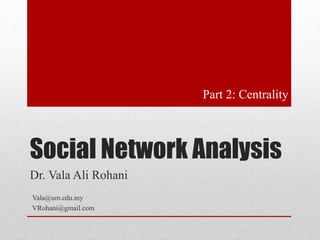Social Network Analysis (Part 2)
- 1. Social Network Analysis Dr. Vala Ali Rohani Vala@um.edu.my VRohani@gmail.com Part 2: Centrality
- 2. different notions of centrality In each of the following networks, X has higher centrality than Y according to a particular measure Y X Y X X Y Y X indegree outdegree betweenness closeness
- 3. review: indegree Y X
- 4. trade in petroleum and petroleum products, 1998, source: NBER-United Nations Trade Data
- 5. ŌĆó Which countries have high indegree (import petroleum and petroleum products from many others) ŌĆó Saudi Arabia ŌĆó Japan ŌĆó Iraq ŌĆó USA ŌĆó Venezuela Quiz Q:
- 6. review: outdegree Y X
- 8. ŌĆó Which country has low outdegree but exports a significant quantity (thickness of the edges represents $$ value of export) of petroleum products ŌĆó Saudi Arabia ŌĆó Japan ŌĆó Iraq ŌĆó USA ŌĆó Venezuela Quiz Q:
- 9. putting numbers to it Undirected degree, e.g. nodes with more friends are more central.
- 10. normalization divide degree by the max. possible, i.e. (N-1)
- 11. real-world examples example financial trading networks high in-centralization: one node buying from many others low in-centralization: buying is more evenly distributed
- 12. In what ways does degree fail to capture centrality in the following graphs? what does degree not capture?
- 13. Brokerage not captured by degree Y X
- 14. betweenness: capturing brokerage ŌĆó intuition: how many pairs of individuals would have to go through you in order to reach one another in the minimum number of hops? X Y
- 15. betweenness: definition ├ź CB (i) = gjk (i) /gjk j<k Where gjk = the number of shortest paths connecting jk gjk(i) = the number that actor i is on. Usually normalized by: CB ' (i) = CB (i ) /[(n -1)(n -2) /2] number of pairs of vertices excluding the vertex itself
- 16. betweenness on toy networks ŌĆó non-normalized version:
- 17. betweenness on toy networks ŌĆó non-normalized version: A B C D E ’ü« A lies between no two other vertices ’ü« B lies between A and 3 other vertices: C, D, and E ’ü« C lies between 4 pairs of vertices (A,D),(A,E),(B,D),(B,E) ’ü« note that there are no alternate paths for these pairs to take, so C gets full credit
- 18. betweenness on toy networks ŌĆó non-normalized version:
- 19. betweenness on networks ŌĆó non-normalized version: A B C E D ’ü« why do C and D each have betweenness 1? ’ü« They are both on shortest paths for pairs (A,E), and (B,E), and so must share credit: ’ü« ┬Į+┬Į = 1
- 20. Quiz Question ŌĆó What is the betweenness of node E? E
- 21. betweenness: example LadaŌĆÖs old Facebook network: nodes are sized by degree, and colored by betweenness.
- 22. Quiz Q: ’éżFind a node that has high betweenness but low degree
- 23. Quiz Q: ’éżFind a node that has low betweenness but high degree
- 24. closeness ŌĆó What if itŌĆÖs not so important to have many direct friends? ŌĆó Or be ŌĆ£betweenŌĆØ others ŌĆó But one still wants to be in the ŌĆ£middleŌĆØ of things, not too far from the center
- 25. need not be in a brokerage position Y X Y X X X Y Y
- 26. closeness: definition Closeness is based on the length of the average shortest path between a node and all other nodes in the network Closeness Centrality: N ├ź ├¬ ├¬ -1 ├║ ├║ Cc (i) = d(i, j) j=1 ├® ├½ ├╣ ├╗ Normalized Closeness Centrality ' (i) = (CC (i)) /(N -1) CC
- 27. closeness: toy example A B C D E ' (A) = Cc d(A, j) N ├ź j=1 N -1 ├® ├¬ ├¬ ├¬ ├¬ ├½ -1 ├╣ ├║ ├║ ├║ ├║ ├╗ = 1+ 2 +3+ 4 4 ├® ├½ ├¬ -1 = ├╣ ├╗ ├║ ├® 10 4 ├½ ├¬ -1 = 0.4 ├╣ ├╗ ├║
- 29. Quiz Q: Which node has relatively high degree but low closeness?
- 31. Connected Components ŌĆó Strongly connected components ŌĆó Each node within the component can be reached from every other node in the component by following directed links ’ü« Strongly connected components ’ü« B C D E ’ü« A ’ü« G H ’ü« F ’ü« Weakly connected components: every node can be reached from every other node by following links in either direction A B C D E F G H A B C D E F G H ’ü« Weakly connected components ’ü« A B C D E ’ü« G H F ’ü« In undirected networks one talks simply about ŌĆśconnected componentsŌĆÖ
- 32. Giant component ŌĆó if the largest component encompasses a significant fraction of the graph, it is called the giant component http://ccl.northwestern.edu/netlogo/models/index.cgi















![betweenness: definition
├ź
CB (i) = gjk (i) /gjk
j<k
Where gjk = the number of shortest paths connecting jk
gjk(i) = the number that actor i is on.
Usually normalized by:
CB
' (i) = CB (i ) /[(n -1)(n -2) /2]
number of pairs of vertices
excluding the vertex itself](https://image.slidesharecdn.com/snaslides2-141008213416-conversion-gate01/85/Social-Network-Analysis-Part-2-15-320.jpg)
















